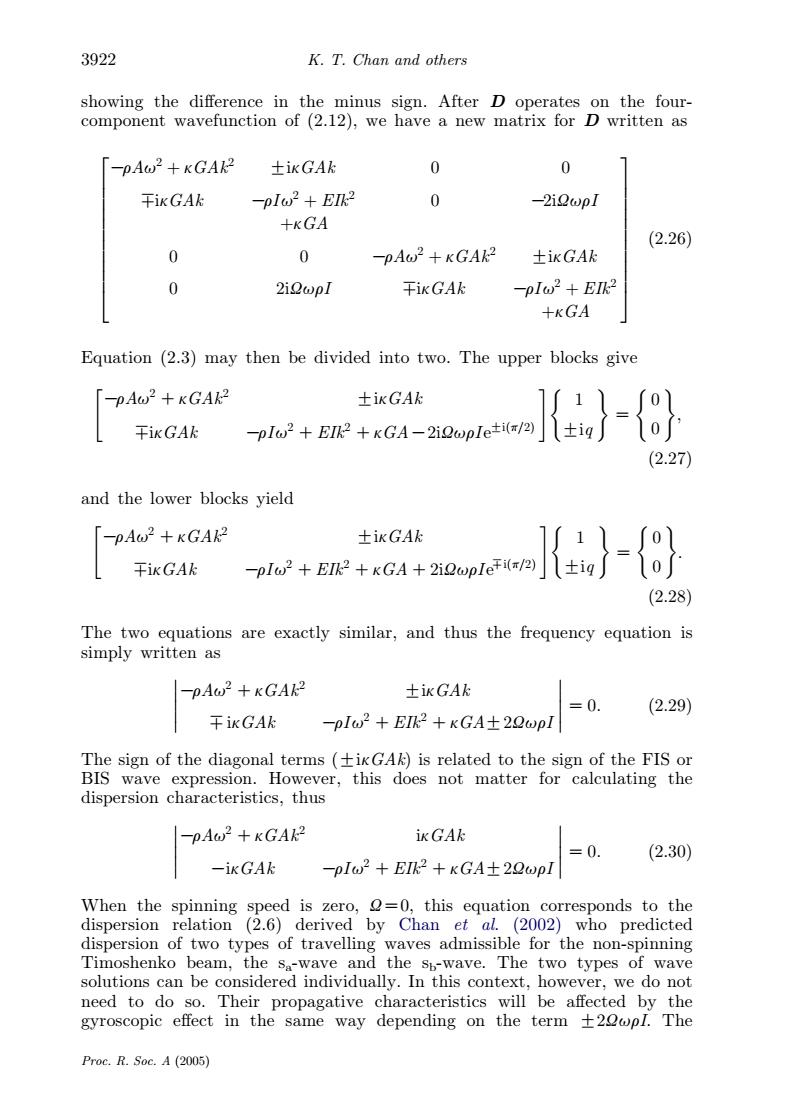正在加载图片...

3922 K.T.Chan and others showing the difference in the minus sign.After D operates on the four- component wavefunction of (2.12),we have a new matrix for D written as -pA02+KGAk2 ±iKGAk 0 0 干iKGAk -pIo2+EIk2 0 -2iQwpI +KGA (2.26) 0 0 -pAo2+kGAk2 ±iKGA 0 2iQwpI 干iK GAk -pIo2+EIk2 +KGA Equation (2.3)may then be divided into two.The upper blocks give -pA02+KGAk2 ±ik GAk 干iK GAk -pI02+EIk2+KGA-2iQwpleti(/2) }-8 (2.27 and the lower blocks yield -pA@2+KGAk2 ±ik GAk 干iK GAk w+E]{生}-日} (2.28) The two equations are exactly similar,and thus the frequency equation is simply written as -pAo2+KGAk2 士ik GAk =0 (2.29) 干iK GAk -pIw2+EI2+KGA士22wpl The sign of the diagonal terms (tikGAk)is related to the sign of the FIS or BIS wave expression.However,this does not matter for calculating the dispersion characteristics,thus -pAo2+KGAk2 iK GAk 0 (2.30) -ikGAk -pI02+EIk2 +KGA+2QwpI When the spinning speed is zero,2=0,this equation corresponds to the dispersion relation (2.6)derived by Chan et al.(2002)who predicted dispersion of two types of travelling waves admissible for the non-spinning Timoshenko beam,the sa-wave and the sp-wave.The two types of wave solutions can be considered individually.In this context,however,we do not need to do so.Their propagative characteristics will be affected by the gyroscopic effect in the same way depending on the term +2Qwpl.The Proc.R.Soc.A (2005)showing the difference in the minus sign. After D operates on the fourcomponent wavefunction of (2.12), we have a new matrix for D written as KrAu2 þ kGAk2 GikGAk 0 0 HikGAk KrIu2 þ EIk2 0 K2iUurI þkGA 0 0 KrAu2 þ kGAk2 GikGAk 0 2iUurI HikGAk KrIu2 þ EIk2 þkGA 2 6 6 6 6 6 6 6 6 6 6 4 3 7 7 7 7 7 7 7 7 7 7 5 ð2:26Þ Equation (2.3) may then be divided into two. The upper blocks give KrAu2 CkGAk2 GikGAk HikGAk KrIu2 CEIk2 CkGAK2iUurI e Giðp=2Þ " # 1 Giq ( ) Z 0 0 ( ); ð2:27Þ and the lower blocks yield KrAu2 CkGAk2 GikGAk HikGAk KrIu2 CEIk2 CkGAC2iUurI e Hiðp=2Þ " # 1 Giq ( ) Z 0 0 ( ): ð2:28Þ The two equations are exactly similar, and thus the frequency equation is simply written as KrAu2 CkGAk2 GikGAk HikGAk KrIu2 CEIk2 CkGAG2UurI Z0: ð2:29Þ The sign of the diagonal terms (GikGAk) is related to the sign of the FIS or BIS wave expression. However, this does not matter for calculating the dispersion characteristics, thus KrAu2 CkGAk2 ikGAk KikGAk KrIu2 CEIk2 CkGAG2UurI Z0: ð2:30Þ When the spinning speed is zero, UZ0, this equation corresponds to the dispersion relation (2.6) derived by Chan et al. (2002) who predicted dispersion of two types of travelling waves admissible for the non-spinning Timoshenko beam, the sa-wave and the sb-wave. The two types of wave solutions can be considered individually. In this context, however, we do not need to do so. Their propagative characteristics will be affected by the gyroscopic effect in the same way depending on the term G2UurI. The 3922 K. T. Chan and others Proc. R. Soc. A (2005)